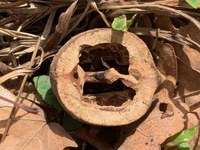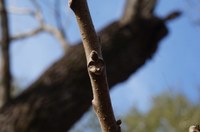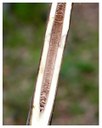Protecting Black Walnut Trees
February 2022
By Ranger Amy

- Black walnut
Did you know that black walnut trees are illegally poached in the United States? As timber prices soar, a single black walnut tree can be worth $50,000!
This tree is critical to our hardwood forests and ecosystems. The Walnut Ridge Unit part of our park gets its name from this tree.
Citizen scientist at work
To help protect this tree, park volunteer Gloria Chavez joined a citizen science project, Adventure Scientists. Adventure Scientists provided her with training, permits and equipment to collect tree samples.
Gloria collected samples from MDJSP, Huntsville State Park, and the Sam Houston National Forest. The genetic data from these trees go into an online database.
Tree ID

- Black walnut leaf scar

- Black walnut pith
The easiest way to identify a black walnut is to find walnuts on or around the tree or check its leaves. In winter, walnuts and leaves may not be around. Gloria identified the trees through their leaf scar and pith.
The leaf scar is the area on the stem where the leaves were attached. A black walnut’s leaf scar has a “monkey face” on it, left from the three vascular bundles.
The pith is the inside of a stem or twig, and a black walnut‘s pith is chambered and dark brown.
Volunteer thanks
These hands-on citizen science projects protect our forests. In 2021 a federal case led to prosecution based on the data from this project. That would not have been possible without the help from volunteers like Gloria Chavez.
Thank you, Gloria, for taking part in this project and protecting our forests!
